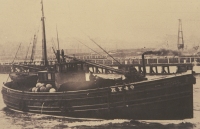Herring Home | Fishing for herring | Next
Development of Engine Power
In the late 19th century, another big change began to take place. This was the introduction of steam engines to fishing boats. It was soon followed by the development of motor engines. This led to a dramatic change in herring fishing patterns as it meant that fishermen could go to sea whenever they wished. They could now overcome adverse weather conditions and no longer needed to worry about calm seas.

The first steam drifter was built in Leith in 1880. By 1882 there were 7 Scottish steam drifters working in the herring fishery. The main building phase was between 1900 and 1914. By 1914 there were 981 steam drifters and they made up a large part of the East Coast fleet. The introduction of the steam drifter led to a boom in herring fishing at the beginning of the 20th century. However, bigger catches were due to larger boats, with the actual number of fishermen and boats falling.

By 1906, motor engines were being developed. These engines were inexpensive and compact. Motor engines revolutionised the inshore fishing industry. They could be fitted to existing sailing boats as well as new boats. By 1915 there were more motorboats than steam boats in Scotland. Their numbers continued to increase during the First World War, as it was often easier to obtain fuel oil than coal. By 1919 there were 1830 motor powered boats. From the 1920s, custom-built diesel boats also began to be used. The number of motor boats continued to increase during the 1920s and 1930s, but not to the same extent as previously. Herring fishing was suffering by this time and the fishermen were less well off.
Sailing boats continued to be used and it was the 1930s before the number of sailing boats dropped off. They were cheaper to buy and run, which was important for younger fishermen. Also, many fishermen who had recently purchased such vessels could not afford to replace them. The last Scottish steam drifter was built by Alexander Hall of Aberdeen in 1932. By 1954 there were only six Scottish steam fishing boats. Motor boats had become more efficient and cheaper.